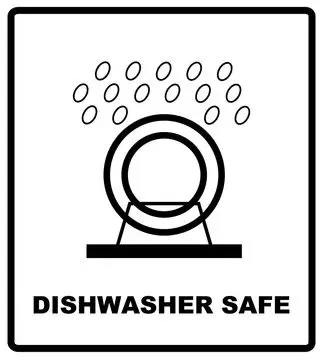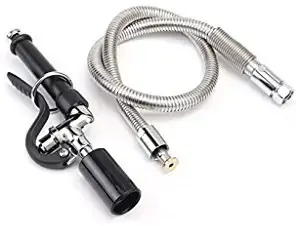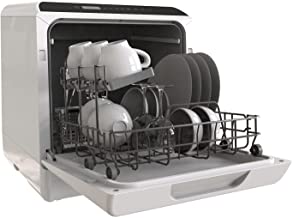General Tips on Dishwasher Maintenance
Dishwashers vary somewhat from one brand to another; however, they all function similarly.
Your dishes are held in detachable, sliding racks. Water sprays from beneath with the help of a spray-arm to get rid of debris and food from your dishes.
Food items that fall away from your dishes accumulate in a trap in your dishwasher interior’s bottom part.
The trap is detachable, and you should remove it and clean it out every so often to get rid of food particles and dried soap. To make sure your dishes emerge clean, you should ensure the trap remains clean.
The dishwasher’s sprayer arms function by spinning to help make sure sprayed water will get to all dishwasher’s surfaces, both the bottom and top.
Small holes positioned at normal intervals along the dishwasher’s arms help to spray water out. Ultimately, these holes will get clogged with dried soap and debris particles.
To help make sure the dishes become spotless, cleaning the spray arms holes from time to time is important.
Make a solution of water and vinegar and soak the arm. After that, clean the holes using a regular pipe-cleaner.
If you have an issue of water leakage onto the ground around the dishwasher’s front part, the issue might be a worn-out or damaged gasket around the door of your machine. Usually, you can take out the gasket easily.
If you have seen rust in the dishwasher or on the dishes, it might be that some of the racks prongs coatings are coming off.
You can get affordable dishware repair kits and include rubber tips and vinyl paint that you can use to cover corroded areas on the prongs.
There are simple ways of maintaining your dishwasher. You can keep it working well and doing magic on the dishes after every cycle by doing maintenance every couple of months.
No products found.
Dishwasher Machine Maintenance Tips
One of the most important maintenance strategies for your dishwasher is learning how to clean and dry your dishwasher the right way.
Rerunning a full cycle
After you unclog and clean up every section of your dishwasher’s interior, it is best to switch it on for another cycle. This will let everything get washed thoroughly.
Removing residue in the door’s outer surface and gasket
Get rid of detergent powders and grease that accumulate from the rubber gasket using a damp clean cloth. The door will close and seal well, thanks to a well cleaned up gasket.
After that, use a clean, soft cloth to wipe your door’s outer surface. Follow the instructions on the manual or on the internet for the right type of detergent to use.
Cleaning the interior and edges
Often, the unpleasant odors you might notice originating from the machine might be originating from the exterior areas around your dishwasher.
The edges around the appliance’s door may have lots of pieces of food debris and spills as they don’t get washed during a normal cycle.
A little regular hose cleaner and a wet cloth are enough for wiping this area. You can also use it to wash the outer door and buttons of the dishwasher.
Other areas you need to clean include:
- Under the door, in the interior
- Flatware basket
- Gasket
- Detergent dispenser
Allow the machine to air dry
After unloading the dishwasher, you might get tempted to begin filling it up immediately. This will help stop bacteria’s growth and make it simpler for you to keep the machine clean.
Know non-dishwasher safe items

You can be tempted to place all the dishes in the machine; however, not all items are safe to clean in the dishwasher, and you may end up getting them or the machine damaged.
If you are not sure if an item is dishwasher safe, it is best to verify if items have a safe dishwasher label.
Do not put items made with cast-iron, copper, and wood and in the dishwasher.
Many non-stick pans allege to be safe for use in a dishwasher; however, it is best to hand-wash them to prevent this coating getting damaged.
Be careful with fragile glassware and follow the manufacturer’s instructions.
Washing around the drain
You can find your dishwasher’s drain at the bottom of your machine.
The drain builds up crumbs, food scrubs, and usually, tiny plastic pieces and other debris that enter a dishwasher.
Clogging is one popular reason for dishes remaining dirty even after you have washed them in a full run in the dishwasher.
In addition, examine the areas around the drain and wipe dirt around the exterior using a damp sponge.
Occasionally, cleaning around the exterior doesn’t clear clogs, and you should remove it to do full maintenance. A severe clog coming from dirty water will not drain well.
In addition, it might be an indication the pump will end up working harder than usual to overcome the limitation created by the clogging, which will in turn result to faster wear and tear on the machine.
Seek the services of an expert technician to take care of problems with the machine drain.
Use the correct amount of soap
Most people think that if a bit of dishwasher detergent is great, then plenty of it is even better.
That isn’t essentially the case since adding lots of detergents might damage the dishwasher.
The accumulation of excess detergent can get into the electrical or motor components and cause malfunctioning.
Rinsing the dishwasher’s interior
You can use warm, lathered water on the dishwasher’s back, walls, and bottom. You can put a slanted brush to get access to the machine’s back walls.
After that, go to the liquid dispenser, and you may be surprised by the build-up fragments there.
If there’s a build-up of some powder scraps, you’ll require pieces of a toothpick or an old toothbrush to get rid of them.
Wash frequently
One of the best ways of making sure the machine is excess build-up free is to run it frequently. Using the machine regularly will ensure debris doesn’t settle in the dishwasher’s bottom.
This will help minimize the amount of times you should provide it with a thorough clean up throughout the year.
Scrape versus no scrape
Older models might get clogged if you don’t scrape the dishes first. Conversely, more modern dishwashers work better if you don’t scrape or rinse them at the start.
The reason being, they have a soil sensor that will help the unit establish how much water to make use of.
Knowing whether you need to scrape the dishes can help the appliance work more efficiently. For this reason, it will mean less stress on the machine and eventually fewer fixes.
Whether you need to scrape the dishes or not before you start cleaning them, you need to examine and clean up the filters and screens of the dishwasher frequently.
Replace the screens if they get holes, and whenever the old filters get too filthy to clean, you should install new ones.
Do not overfill the trays
In case you have many dishes to clean, do not overload the trays. This may lead to dishes remaining dirty even after washing since there’s no space between them to allow for water circulation.
It can also lead to damage as the dishes bump onto each other when the cycle is on. Ensure that dishes have enough room to become clean.
Getting rid of residue from the spray nozzle and spinning arms

The machine’s spinning arms come with holes where water gets released from when it spins. Sometimes crumbs fill the round openings.
If you start seeing the dishes aren’t fully rinsed, these holes might be the source of the problem. Use a toothpick to take out any fragments that might be stuck in these holes.
In addition, you should examine the arms to verify whether they are spinning well. Several models have a spray nozzle on the bottom, and it looks the same as the upper section of the spinning arms.
In addition, mineral residues will build up inside the machine’s spray nozzle. To remove them, you require a small pipe cleaner or pieces of a toothpick.
Make sure you review the manufacturer’s manual for accurate instructions on cleaning up this section when needed.
Cleaning up the door’s edges
Inspect and get rid of the crumbs around the inside and on the bottom section of your machine door.
Scraps from food items accumulate here, as well, and each time you closed the door.It becomes layered over and tangled with some other particles of food items.
A new toothbrush can take out the stuck bits, and then rinse it with a warm lathered sponge to match the door’s inner section that often gets washed during a cycle. If it’s properly done, it will appear to look new inside and out.
Cleaning the seals of your dishwasher
This unit’s seals create a firm seal between the door and the washer to stop leaking water during the washing cycle. You can usually find the dishwasher seals on the outside edge of the door’s interior side.
In addition, they frame the machine on the interior. Their color makes them easy to recognize; they are usually white or black. Once you see them, you can clean them using a bleach or vinegar solution.
Inspect the spray arms frequently

Dirt will build up inside the jets, which makes these less operational.
If the manufacturer’s manual recommends, you should remove them, unclog any food scraps and ensure the jets flow freely by cautiously uninstalling the unit’s spray arms and pushing a toothpick into water holes.
Washing the filter
Although many dishwashers come with filters, still few machines come without one. If you’ve bought a dishwasher with a filtering gadget, remove it then wash. After that, return it to the same precise area.
Ideal for cleaning up gaps and filters where food items accumulate, a toothbrush will enable you scrub away grease and grime easily in those hard to get to spots.
Cleaning the screen
Inspect the dishwasher’s bottom part. If it resembles many models, there’s most likely a screen.
Made to catch fallen silverware and big pieces of food items, you should frequently clean up the screen to stop nasty smells and blockage.
Ensure the drain line is effective
Most home plumbing drains have a U-shape drain trap. This will help in saving the lost ring and fight smells at the same time by making a waterproof seal between the dishwasher and the sewer line.
But at times, somebody can wrongly fix this drain on the wrong side of the drain, which potentially allows smell drift into the house. Inspect the drain line and make sure it’s on the right side.
Loading the dishwashing machine well
When you have more soiled dishes than normal, it may be tempting to use a single load to try and stuff them all.
It is important to note that when you overload your washing machine with overly soiled dishes, you’re placing more stress than needed on the machine.
Besides overloading, loading repeatedly within a short duration is also harsh on the dishwasher since it makes it ends up overworking the machine. As such, it might lead to the dishwasher to deteriorate quickly.
You may also see leaks as an excessively full unit makes the bottom have excess water. This excess water should go somewhere, and often that area is beneath the dishwasher or onto the floor.


